American Sabbatical 041: 10/28/96
Fort Ross
10/28.. Ukiah
We stocked up on roadfood at the Arcata Co-op in the AM, rolled out onto California 101,
tuned up the CW-FM, and let’er smoke for south. We took the highroad
for about 15 miles before we jumped ship, heading for Ferndale.
That hamlet is one long row of western falsefronts in wood and
stucco, all tarted up in boutique colors. Ferns and eucalyptus..
maybe it’s all the rampant eucalyptus towering over the valley
byways, but even the roadsides smell like boutiques out here.
We wanted to make a loop along the coast, but couldn’t find the
sideroad out of Ferndale, so we stopped an elderly gent out on
his morning constitutional. And got the entire history of the
universe, centered on Ferndale. Well, we had to see Petrolia,
where oil was first discovered in CA, and Honeydew.. well Honeydew
used to be the heart of Marijuanna Country, he winked. OK!.. let’s
go, we crowed.
In a blink we were inching along another paralyzing pathway scribed
on the side of a mountain. 15-20 mph fish-hooks and rollercoasters
with the Owl’s brakes smoking on the downgrades. Peggy is getting
fingercramps from hanging on. But the views are spectacular. Behind
us the coastal plain running up to Ferndale is green and steamy
with agricultural fertility, just like the “reclaimed” marshes
around Arcata. The onshore wind, starting to rise, is pushing
a misty haze up against the evergreen hills surrounding the Humbolt
Valley, as it disappears in our rearview, between the heights.
Over the first ridge, and we are in the Scottish Highlands. Leaping
and diving moorland.. beige dry grasses with a lowering gray overcast.
Occasionally we can spot the roof of a ranch house far below in
the deep valleys, and there are horses and cattle scattered decoratively
about the abrupt landscape. After 40 minutes of wiggling up and
gasping down this sear upland we start getting flashes of a roiled
green sea between the slopes. Then one long yodeling drop spits
us out on the beach. Where we stop to cool the Owl, and our selves.
| A great hawk hovers over us, frothering its wings, and dives into
the grass alongside. The wind is up now, chill off the water,
and we could easily be on a Celtic beach. The flotsam is all small
junks of wood.. no seaweed, no shells, only the odd pebble.. a
well scoured strand. And the nipping breeze drives us back to
Red Owl after an abbreviated ramble. |
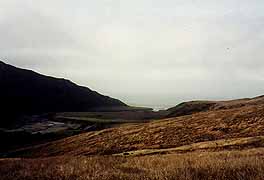
Scot's Coast
|
A couple more miles of surf-stomped foreshore and we have our
noses pointed at the sky again. As the land rises the vegetation
lushens. First gigantic eucalyptus (an immigrant) and full blown
hardwoods in the bottoms, and then mixed needle-leaf secondgrowth
reaching for the sky. Our heart-in-mouth views are of staggered
rows of conical upheavals, topped with dark evergreens and streaming
mist, and pocket ranches on the green valley floors. We leave
Honeydew behind us in the Matole Valley and crawl up and over
the coastal divide. Skidding down through the switchbacks, the
big trees loom up beside us. We are in another holy grove.
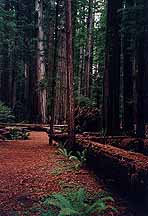
Roosevelt Grove
|
Our twisted path had brought us into the Roosevelt Grove of Humbolt
Redwood State Park. There the pavement narrows and twines between
the stupendous mist-catchers. The oldest of these ancient coastal
redwoods have been drinking the oceanic precip since god was a
boy (if you’re of the Christian persuasion), and their absolute
indifference to our momentary passing is humbling. These are no
kindred to our hastiness. Perhaps it is understandable they seem
to play no part in the native mythology. They are simply alien
beings who endure our insults without engagement.
|
The Roosevelt Grove lies in a creek bottom (the east fork of the
Eel), unlike the Ladybird Grove which climbed a dizzy slope, and
there is virtually no undergrowth beneath the exalted pillars.
You can see row after row of impossible stems. Here are processional
ways fit for the gods. And no birds sing. Sequoia sempervirens
are so chemically hostile to insects and other plants that they
create a solitary universe, and the hush of these cool dank aisles
doesn’t entice you to linger.
We walked through the dripping silence to the foot of THE TALLEST
TREE IN THE WORLD. 363 feet short of heaven. The ultimate neck
twister and hush yo mouth. We put the Owl in 1st gear and squiggled
our way toward the daylight. But our sideway turned into the Avenue
of the Giants, twenty miles of tree dodging. Indeed it felt sacrilegious
to be slaloming through the big sticks at 35mph with Californos
at our back. In the breaks there were roadside attractions, especially
chainsaw megacarvings. From Orick to Sausalito, Highway 101 could
be called the kitsch-carvers’ hall of fame. Some of the burl carvings
and gigantosculpts are figures of power, but most of them are
a child’s nightmare of tacky trinkets. Everything is bigger out
west.
|
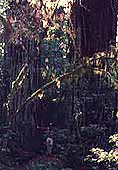
Dwarfed
|
You have to give credit to the C state, though. The highways funnel
down to a trickle-lane for the big trees. In fact 101 is a schizophrenic
episode for the through traveler. Fourlane with a breakdown for
slow traffic, pinching down to twolanes for 10mph hairpins, followed
by a gawking meander through the redwoods, then back to fourlane
flank speed.
When 101 breaks out of the lofty greenstuff you are back in rainshadow
country. Crisp khaki grasslands, scrub oak and madrone parklands
on the rolling slopes, and irrigated agriculture along the bottoms.
Vinyards, orchards, hops. This is the landscape out of cartoons.
Sweeping beige hills scattered with romantic cedars and junipers
rising up to hardedged groves of evergreens. Every panorama looks
like a storybook painting. All it needs is a turreted castle out
of Fantasyland. You know that Disney was a Californian.
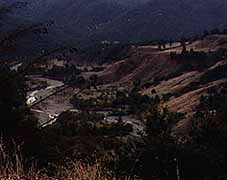
Disney Valley
|
The Russian River Valley is another of the fertile north-south
valleys between the cataclysmic ranges. Only now the agriculture
is crowding out the ranching and the grape is climbing the sidewalls.
We sloped down the offramp into Ukiah as our local star finally
gave up the contest with cumulonimbus and slid behind the coast
ranges. We were hunting for a dry spot, and (billboard) rumor
had it there was a Motel6 in town. But we got all turned round
and ended up passing through the mandarin portals of Buddhist
University. We hung a hard OM and stopped at the nearest grocery
for directions. None of the East Indians in the place could find
enough English to help us. Civilization approaches. |
And that means vegetables! We actually followed our noses into
Ellie’s Vegetarian Restaurant and Mutt House. We didn’t ask about
the latter, just relished in the garden truk.. right out on the
strip with Motel6. Almost heaven.
10/29.. Bodega.
Up in the morning and off to school.. heh heh, just joking. Actually we had multiple quests today.
First the big solar calendar in Hopland, then Torbertville. We
stocked up on fresh bread and java and wondered at all the bookstores
and cafes in this county seat (Mendicino). Is it a good thing
when lawyers read? We remarked on the educated diction of the
downtown service people, and wondered if that was a sign of the
educated choosing where they live over economic opportunities,
or just signs of a lousy economy. Peggy quoted a friend who says
only 50% of PHds get to work in their chosen field. Pass the latte.
Hopland was just a skip and a jump down the Redwood Highway from
Ukiah, and the Real Goods Showroom and Futuristic Environment
is just off 101. The site rivals classic KOA campgrounds.. between
the interstate and the railroad on a dry flat abandoned industrial
strip. But this is visionary reclamation, not Winnebagology. Real
Goods is an alternate technology mailorder vendor and their roadside
pitch is equal parts New Age and buy now, environmental design
sophistication and yuppie consumerism, eucalyptus and barcodes.
Entering the grounds through radial lines of young plantings,
which echo the agricultural linearity of the regional vineyards
and orchards, we entered the carpark, whose drainage feeds into
micromarshes designed to filter out the heavy metals from the
runoff. LLBean take note. Then we picked up brochures for the
self-guided tour. Vinecovered ramadas for oxygenation and cooling,
trickling fountains and mossy ponds and winding channels for waste
purification, fish to eat the algae.. the whole ark. The central
courtyard, enclosed to the north by the showroom building, is
a 1/4 acre solar calendar, with notched stones on the perimeter
marking the solstice and eqinoctial sunrise and sunset, and a
radial paving installation. The solarheated showroom is strawbale
construction with huge south windows. In addition to all this
passive organic design there are arrays of tracking solar panels,
battery power grids, interstellar wire webs and architectology.
Like a garden in a space station. Bucky Fuller and The Druids
meets Mendicino County. A renewable resource technology is very
attractive intellectually, and organotechnics smell good, but
I found this prototype of the future curiously reminiscent of
the 1964 New York Worlds Fair.. nice world to visit, but could
you live there? Even so, we started talking about a ramada out
back in Bowdoinham.. without satellite dish.
Our next stop was an experiment in recent historical research.
Our friends Jim and Theta Torbert lived up in the Mendicino hills
twenty years ago, raising goats and living the life. They decamped
due to a collapse in the goatmilk market, and after sojourns in
Arkansas and Maryland, have been our neighbors and compatriots
in Maine since 1983. We’ve been curious about the world they left.
Their tales made it sound like a rural paradise being swallowed
by exurbia. How would it look to wandering outsiders?
The road from Cloverdale to Yorkville fishtails and swivels into
the sensuous hills, past pocket vineyards, tilted pastures, and
the occasional archispicuous new consumption. This is sheetmetal
edifice territory, rust-streaked barns and tapdancing roofs. To
the ignorant eye this was still rural backcountry set in romantic
panoramas. Cowboy Tuscany.
At the local watering-hole all we could elicit was headshaking.
Nope, before my time. Sorry, all the oldtimers have moved out.
Well, maybe those goatwomen in Boonville would know, but I wouldn’t
go up there, at least I wouldn’t send a man up there, might get
shot. So Bryce uses the old stand-around-and-wait technique. Tell
a few stretchers about the Torberts. “Well, maybe Larry would
know..... LAAARY!”
Sure enough. “Used to live next door. Always like Jim, nobody
ever had a bad word to say about Jim, even after.. Course I never
liked those goats much. Specially that old, whaddycallit, buck?
Stink? Whew.. and mean? The big old buck took to butting the D8
we were using to root up new vineyard. Blam. Blam. He just wouldn’t
quit butting that D8.” It sounded like an emblematic story to
me. Goatman beats his head against mechanized development. What
mythic tales will each of us leave behind?
| Larry pointed us the way to the Torbert ranch of old, now sub-divided
into tickytak houselots, and muttered about too much building,
too many newcomers.. not like the old days (when he got here from
Brooklyn in the 70s). The same noise we tend to make in Bowdoinham.
Maybe we have to move every 20 years so we can have good old days
in new places, without memories of how it was before THEY started
to move in. We didn’t stop to price house lots. |
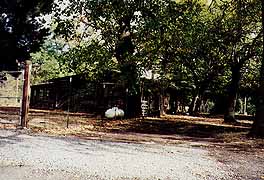
Native Settlement
|
We’d been warned not to take the crossroad to the coast through
the Mailliard redwoods.. all washed out in last night’s downpour.
So we ducked into the Point Arena road, and were back on the snakeway
again. The array of microclimates in the Coastal Ranges, with
their assorted vegetation, makes crossing to the coast an education
in gradients of moisture and verdure, and an exercise in breathlessness.
This corkscrew bit of engineering sure pulled our corks. Another
stretch of spectacular heart massage. When the final descent was
marked “16% grade for the next 10 miles,” even the Owl hooted.
Peggy kept saying, “I can’t imagine trying to drive a truck down
this.. I wouldn’t want to drive a bus down this.. I wouldn’t...”
I was quietly wondering if Red’s brakes were holding up better
than over by Honeydew. If, like Maybelline, the water blowing
up under the hood was maybe doing the motor good...Maybelline,
won’t you be true. And suddenly there are flares in the road,
somebody flagging us down, and we come shuddering and smoking
barely-in-time to a stop, nose-to-tailgate, alongside a big truck
that’s lost it on the downgrade, rolled over, and crumpled into
the trees. The first responders are there, and the sheriff. A
helicopter is clattering overhead, about to set down for a rescue.
And we pull into the next turnout. Let the Owl’s brakes cool for
a spell. I’ve had nightmares about hills with no brakes since
our brakeless beater days, and here’s a reflash reminder. Even
new brakes, on little cars, get too hot on the steep pitches.
Cool it.
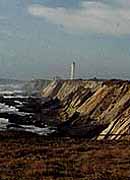
Point Arena
|
We secondgeared it onto the flats, and into another plant community.
Now our road was lined with grand aisles of planted eucalyptus,
100 feet tall and shedding their long peels of bark and New Age
aroma. Alternating with the boutique trees were 40-foot explosions
of Juniper. Their divided trunks and radially ascending branches,
carrying their tight-clustered scaly foliage, make these evergreens
look like huge hurrahs, throwing it all to the wind. And behind
the trees the coastal lowlands displayed the wheaten grasses Peggy
finds so com
pelling. Another California beautyspot, with the Pacific spuming
at the base of its cliffs. The lighthouse on Point Arena is a
lofty white pinnacle whistling in the wind, and blinking at the
breakers. |
Our next target was Fort Ross, a reconstructed Russian trading
base which was occupied into the 1840’s, and we had just about
enough time to get there before the gates closed. So we hotfooted
down the coast road, another scizzy feat of engineering, one minute
fourlane speedway, next a twolane serpentine cliffhanger. I suppose
the Californos get used to skidding past the washouts and straddling
the rockfalls, but these slaloms still turn me insideout.
It was raining intermittently again, which made us wonder at the
parched grasslands around us. And we were surprised by the thinness
of development. As Mendicino turned into Sonoma we were only 50
miles, as the crow flies (more likely big ravens, here), from
San Francisco, but the coastal hills only sported the odd manse.
Huddled in the rivermouth valleys were sparse settlements, the
requisite oysterbar, maybe an inn or two, but not the vacationland
crowding we’d expect.
| A rainbow bent over us as we pulled into Fort Ross. Peggy strode
into the fortifications and I strolled down toward the shore to
do a sketch. As I’ve come to expect along this shore, it turned
into a wetonwet exercise in the rain. With the Pacific swallowing
the day and squall-lines scampering ashore, we put Red’s lights
on and started weaving and bobbing again. We were determined to
camp by the beach, if the weather would clear (as promised). We’d
been shelling out to motel owners like our pockets were bottomless,
and the scale was going up as we neared higher civ. And our stomachs
are happier when we cook for ourselves. |
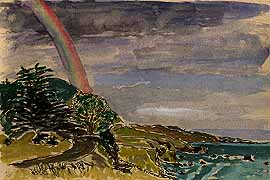
Russian Rainbow
(Bryce)
|
It took us 3 tries to find the entrance to the Bodega Bay State
Park, and we groped into a niche in the dunes, nestled under exuberant
junipers.. cooked up a feast from the food locker.. and zipped
ourselves in by 8PM. Owls came to serenade us, while the waxing
moon played peekaboo through high clouds. Hoohooh..hoo..hoo.
(Memo #37)
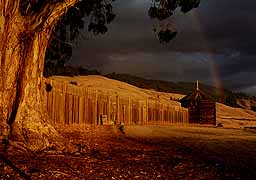
Fort Ross
|
Oct. 29 - Russian Fort Ross, CA.
Who? Russian colonists
What? Russian colony
Where? northern California
When? 1812-1831
How? plan to support colony by boatbuilding and sea otter fur
trade
Topics: Russian exploration and settlement in North America
Questions: How big was the Russian presence in North America?
What was the dominant form of contact - by fur traders, settlers,
missionaries? What remnants of Russian presence are there in North
America? |
Every so often as we travel in the northwest there is a Russian
River or a Petersburg to remind us of another movement to the
area - from Russia EAST to North America. I’ve also seen pictures
of Russian Orthodox churches in tiny Alaskan villages that still
show Russia’s presence. It is a history I want to explore, one
little covered in the US history texts except in a paragraph about
the competition between Russia and Great Britain and the United
States for the northwest territory. Another paragraph will tell
of our purchase of Alaska.
Fort Ross is the reconstruction of a Russian fort on the coast
about sixty miles north of San Francisco. I had read a story in
a north California newspaper about ongoing excavations there and
didn’t know entirely what to expect. We approached from the north
down Route 1 - the two-laned coastal road that twists and turns
on some heart stopping cliff shelves above the ocean. At Fort
Ross the high hills are a bit further back from the sea, so there
are low, gently ascending slopes that provide a coastal grassland
with scattered woods. The Russians occupied Fort Ross from 1812-1841.
At one point there were 59 buildings at the fort.
|
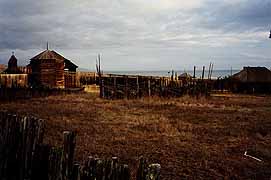
Stockade
|
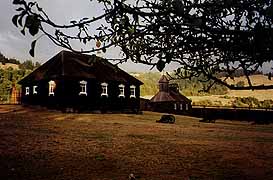
Storehouse
|
Today there is a reconstruction of the fort enclosure with about
twelve buildings, only one of which is original (the Rotchev House
which served as the residence for the commandant). The fort is
a plank-fenced enclosure about three hundred feet across. There
are two blockhouses two stories tall and about fifteen feet square
at the northeast and southwest corners of the fort. The buildings
were all of wood planks with small glass windows. There was a
two-story storehouse with goods in barrels and crates with Russian
labels. One room had the arsenal with guns hanging on hooks and
powder etc. |
| The church was perhaps my favorite building as it had the onion
dome of Russian churches in wood. The building was perhaps thirty
by forty feet and unfurnished, there was a small altar area with
two small icons on the wall and a huge hanging lamp. The enclosure
was grass and dirt with a few small trees growing. |
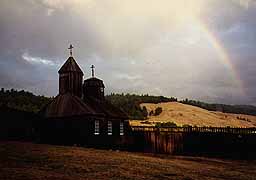
Russian Church
|
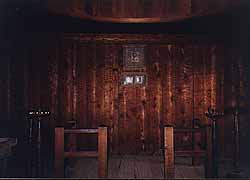
Icons in Church
|
The Russian colonies in northwest North America were established
for the fur trade (especially sea otter). Fort Ross was also intended
to be a shipbuilding center for trade on the coast.
California has a complex history with many First People nations
followed by Russian and Mexican and American colonies. Our first
searches in libraries and bookstores have turned up few sources
on the Russian presence in California and I hope to explore further.
|











